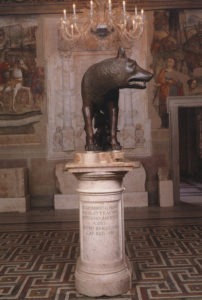
Capitoline Wolf
Do you love Lupa Capitolina? Then you are going to be extremely happy with the forthcoming manifesto on the Capitoline Wolf.
Today at her home at the Capitoline Museum the wolf has many admirers, visitors whose fingers itch to twirl the regular, S-shaped curls of her mane and to caress her sinewy legs, her elegant tufted paws, and her smooth, distended udders. The infinitely abundant images of the wolf on Rome-affiliated merchandise seem to increase rather than dilute the potent aura of the statue herself. What is it about the she-wolf that makes her so compelling?
Scholarship on the origin of disputed bronzes such as Lupa Capitolina (in fact the origin of a number of works including some Etruscan hand mirrors is contested) tend to focus on issues of the absolute. Are the bronzes authentically Etruscan, Roman copies, or 19th Century knockoffs? Do they come from a single workshop? Are they cast by one artist and engraved by another? Whom were these objects made for? Were they part of one group?
I take it as a good thing that, even despite the most thorough scrutiny of Lupa Capitolina imaginable, we do not have answers to any of these questions about her, nor are we likely to find them. No matter what technology can eventually answer about when she was made, Lupa will be able to keep a lot to herself, rendering her enduring mystique, even in its ubiquity, largely impenetrable. Yet this does not mean that questions cannot or should not be asked of or about the wolf; there is satisfaction, not frustration, in this type of open-endedness.
Stay tuned…